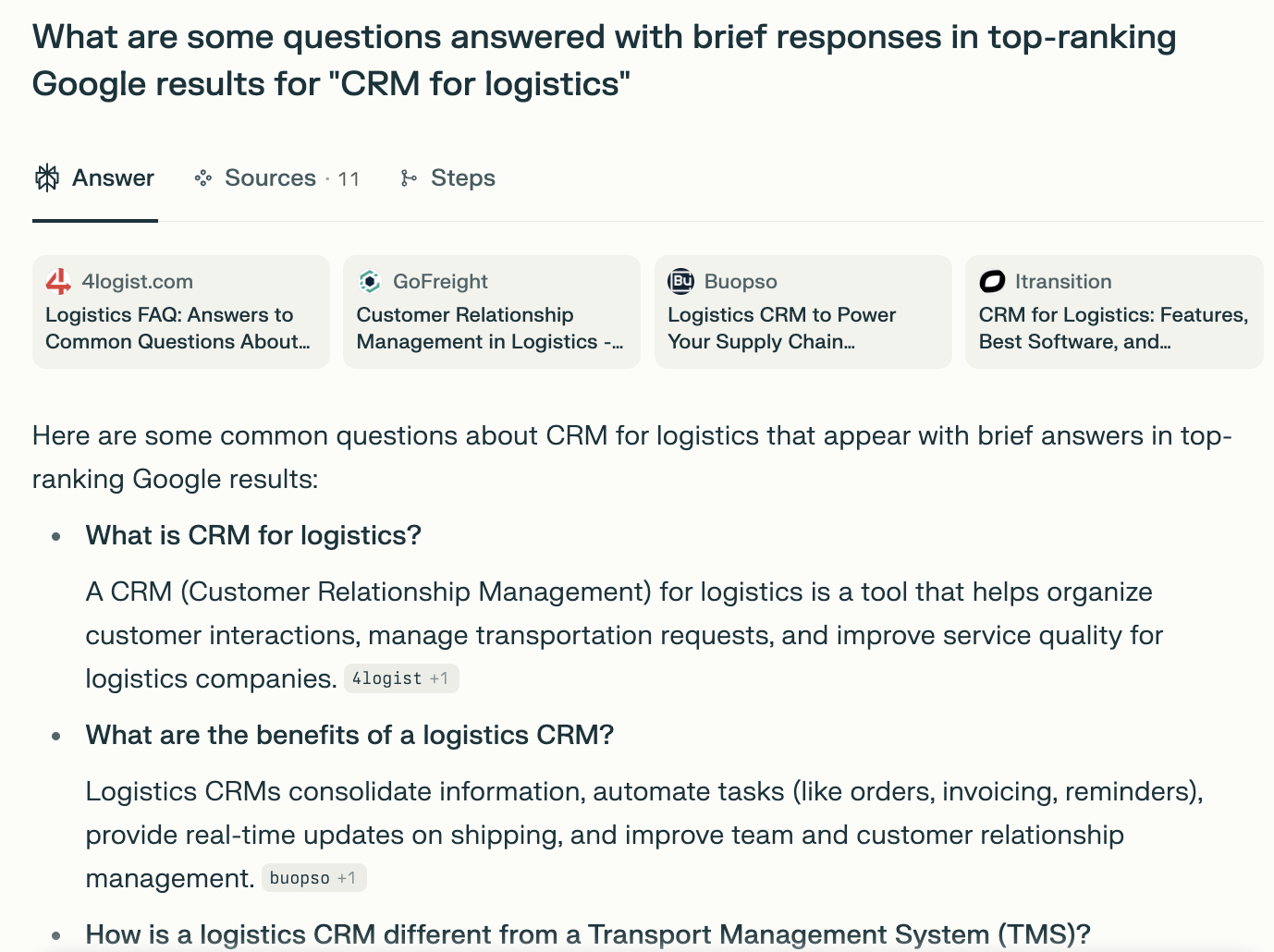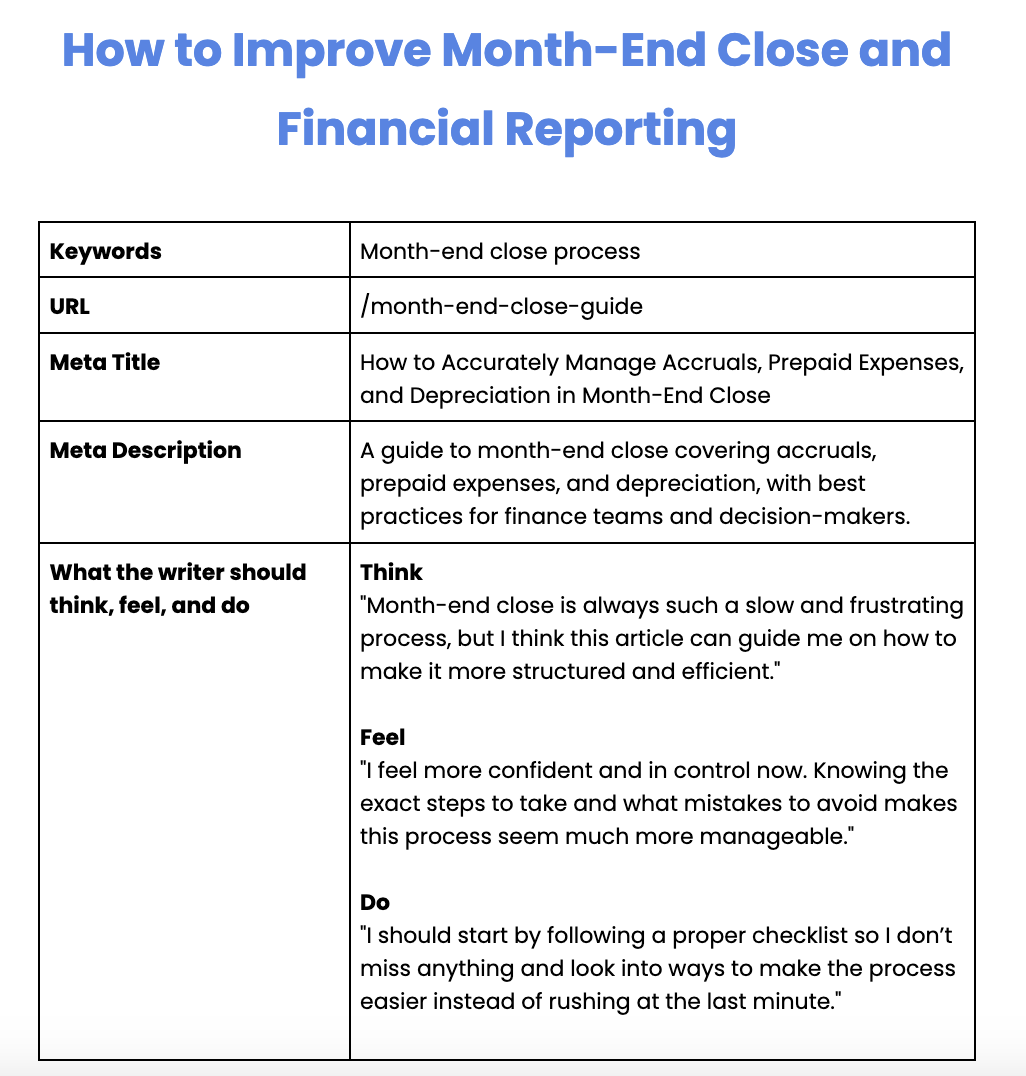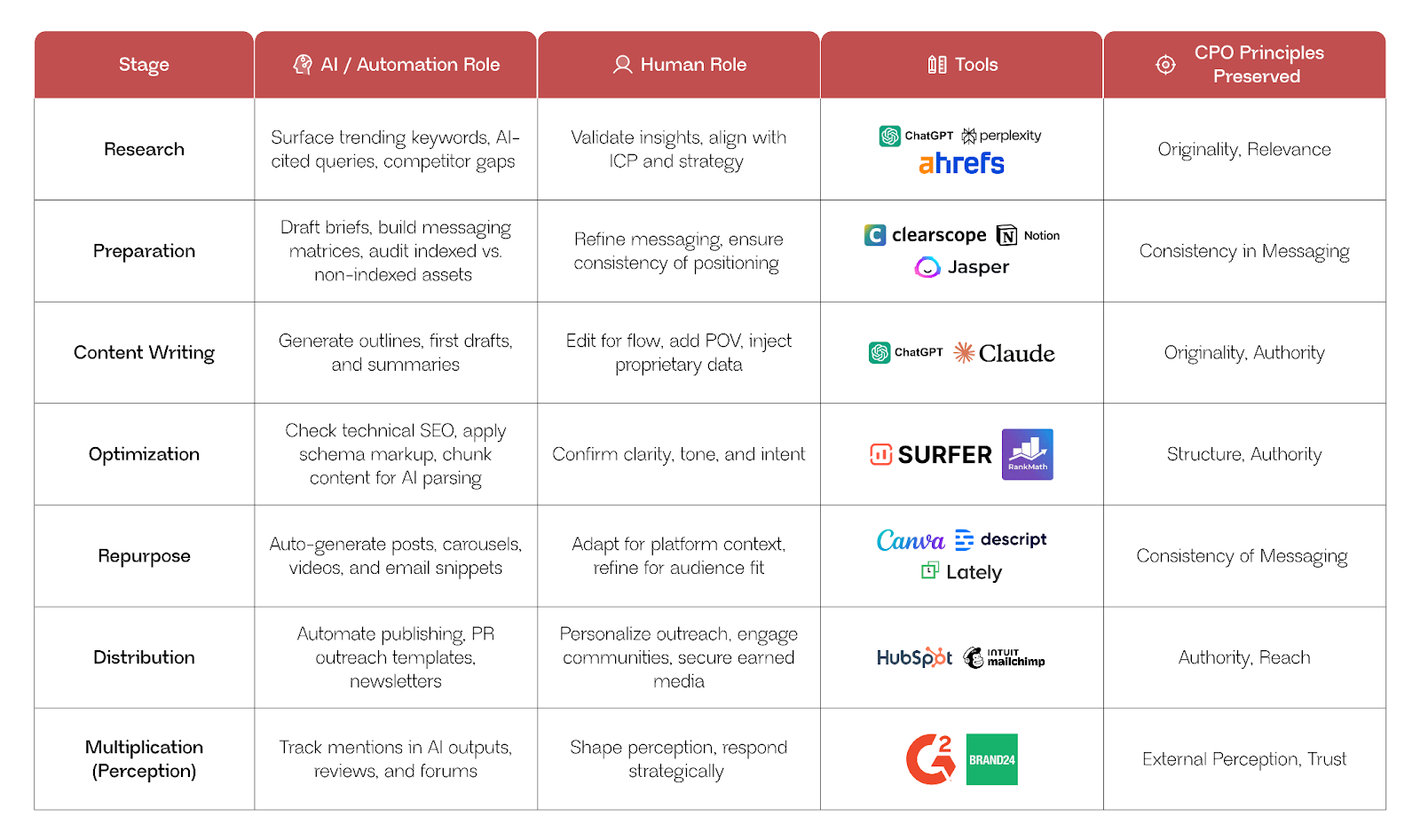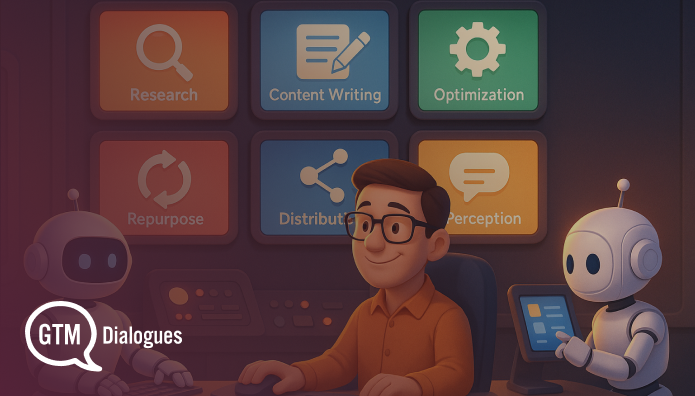Content Process Optimization (CPO) is about ensuring that the content is not only optimized for traditional search engines but also discoverable in AI-driven searches. It expands the scope of SEO into a system that covers research, writing, distribution, and perception.
Content Process Automation (CPA) takes the principles of CPO (consistency of messaging, originality, authority, and perception) and applies AI, automation, and workflow tools at each stage of the process. The result is a system where research is faster, writing is assisted, distribution is automated, and perception is continuously monitored without losing the human oversight.
If CPO is about building the right framework, CPA is about scaling it.
What is Content Process Automation (CPA)?
Content Process Automation takes the principles of Content Process Optimization, and scales it by using AI and automation for speed and efficiency, while humans safeguard originality, consistency, and strategic judgment
At its core, CPA means using technology to reduce manual effort without sacrificing quality. AI tools can now handle tasks like analyzing thousands of competitor pages in minutes, generating first drafts of content, or automatically repurposing a long-form blog into a LinkedIn carousel and email snippet.
Workflow automation ensures that once content is created, it can be scheduled, distributed, and tracked across multiple channels with minimal intervention.
But let me absolutely clear, CPA is not about replacing humans. It is about shifting their role. Instead of spending hours on repetitive execution, teams focus on strategic oversight.
Think of CPA as a three-part balance:
- AI provides scale by scanning, drafting, and repurposing at speed.
- Automation provides efficiency by scheduling, distributing, and monitoring across channels.
- Humans provide judgment by ensuring every asset reflects originality, authority, and brand integrity.
Combining these three, CPA makes content operations faster, more consistent, and more future-proof in a world where both search engines and AI tools determine visibility.
The Seven Stages of Content Process Automation (with AI + Human Mix)
Content Process Automation brings structure to the entire content lifecycle. At every stage, machines provide speed and scale, while humans safeguard consistency, originality, and authority.
Each stage blends AI, automation, and human oversight to maintain consistency, originality, and authority:-
Stage 1: Research
This is where the content journey begins. AI tools like Perplexity and ChatGPT can scan millions of pages to surface trending keywords, competitor gaps, and even highlight which sources AI systems already cite.
For example, if you ask Perplexity “What are the best SaaS onboarding tools?”, it may cite Forbes and G2 but ignore your blog. That insight tells both the gap and the opportunity.
These tools can also give you the kinds of questions and subtopics that appear in top-ranking results. Including these in your content ensures that you don’t just target keywords but also address the exact user intent.

But research without judgment is dangerous. You should definitely filter these insights that matches your business strategy and ICPs. Remember, AI can surface opportunities at scale, but humans must decide which ones truly matter for the business.
Here’s how to put this into practice:
- Use AI search tools (Perplexity, ChatGPT) to run keyword/query style prompts and note which sources are repeatedly cited.
- Extract related questions and subtopics suggested by AI and compare them with Google SERPs to validate overlap.
- Run keyword and topic analysis in Ahrefs/SEMrush. Cross-check with AI citations to identify coverage gaps.
- Build a list of “indexed competitors” (those already cited by AI) vs. “uncited opportunities” (where your brand can break through).
- Have human teams validate which opportunities align with ICPs, positioning, and long-term business goals.
Stage 2: Preparation
Once opportunities and sub-topics are identified, automation can generate content briefs, and messaging matrices. Tools like Clearscope or Jasper can draft detailed outlines within minutes.
Yet, automation cannot ensure consistency of positioning. If AI drafts your messaging as “affordable SaaS solution,” it might conflict with your “enterprise-grade” narrative elsewhere. That’s why you need to validate and refine your brand voice and positioning in outlines.

Preparation becomes the guardrail that prevents mixed signals across search, AI tools, and social platforms.
Here’s how to put this into practice:
- Use AI to generate content briefs with suggested headings, FAQs, and structure.
- Ensure to validates it against pre-built messaging matrix including product description, differentiators, and tone guidelines.
- Audit existing assets to see which are indexed vs. hidden (via GSC + AI prompt testing).
- Finally, refine messaging and lock positioning (so “affordable SaaS” doesn’t conflict with “enterprise-ready”).
Stage 3: Content Writing
Here AI plays its most visible role. It can generate first drafts, summarize complex research, and produce alternative phrasings at speed. For startups with lean teams, this removes hours of manual drafting.
But AI-generated text alone won’t build authority. Originality comes when humans layer in proprietary data, customer examples, and personal insights. A founder’s take on why churn rates spike after onboarding, backed by their own dataset, carries more weight than a generic AI summary. This human input ensures that final content feels authentic, credible, and differentiated.
Here’s how to put this into practice:
- Use AI to draft initial draft, summaries, and multiple headline variations.
- Insert proprietary datasets, case studies, or founder insights into drafts.
- Ensure every section begins with a standalone summary sentence (AI cites these).
- Human editors polish for narrative flow, consistency, and authority.
Stage 4: Optimization
In this stage, AI and automation can handle the technical side like checking for schema markup, ensuring internal linking, compressing images, or chunking content into bite-sized paragraphs that AI tools can reuse.
But optimization isn’t only technical. Human editors ensure clarity of tone, alignment with buyer intent, and narrative flow. Without this step, you risk producing content that looks machine-friendly but feels robotic to human readers. A balance of machine precision and human empathy makes optimized content both discoverable and engaging.
Here’s how to put this into practice:
- Run AI/SEO tools (SurferSEO, Clearscope) to align with search intent.
- Apply schema markup and FAQs so AI and search engines can reuse content.
- Ask for suggestions where other webpages can be naturally linked for internal linking purposes
- Optimize content by chunking long paragraphs into clear, self-contained sections.
- Human editors verify tone, context, and relevance for buyers.
Stage 5: Repurpose
One of the biggest opportunities in CPA is repurposing content at scale. AI can automatically turn a research-driven blog into a LinkedIn carousel, a short-form video script, and an email newsletter draft. This dramatically increases touchpoints without multiplying workload.
However, each platform has its own culture and consumption style. A LinkedIn audience expects thought-leadership, while YouTube Shorts demand quick, visual storytelling. Humans ensure that repurposed content isn’t just copy-pasted but adapted to resonate in context. This prevents your content from becoming repetitive noise across channels.
Here’s how to put this into practice:
- Feed long-form content into AI to create LinkedIn carousels, email snippets, video scripts.
- Automate transcription of webinars into blog drafts using Descript/Whisper.
- Create a repository of “content atoms” (quotes, stats, graphics) to reuse across formats.
- Human teams adapt outputs for context by refining tone for LinkedIn vs. Reddit, for example.
Stage 6: Distribution
Automation ensures your content doesn’t sit idle. Scheduling tools can publish blogs, push newsletters, and post social content across time zones automatically. Outreach templates can scale PR distribution.
But the credibility of distribution comes from human touch.
Journalists won’t respond to templated AI pitches. Communities won’t engage with generic LinkedIn comments. Humans are needed to personalize outreach, build relationships, and create trust. CPA here is about freeing humans from mechanical scheduling so they can focus on higher-value interactions.
Here’s how to put this into practice:
- Schedule content across social and blogs using automation platforms (HubSpot, Buffer).
- Automate newsletter distribution with tools like Mailchimp.
- Build PR outreach templates with AI, but personalize final pitches before sending.
- Engage personally in communities, respond on Reddit/Slack groups, and nurture earned media.
Stage 7: Perception
The final stage is often overlooked: how others perceive your brand and content. AI tools can track mentions in G2 reviews, Reddit threads, and even AI-generated responses to buyer queries. Automation can analyze sentiment trends over time.
Yet, only humans can shape perception. They decide when to respond, how to clarify misconceptions, and how to double down on narratives that are resonating. For instance, if your product is consistently praised in G2 reviews for “ease of onboarding,” your team can reinforce that message in blogs, PR, and community conversations multiplying its impact across ecosystems.
Here’s how to put this into practice:

Importance of Human–AI Balance in CPA
The promise of Content Process Automation is speed, scale, and accuracy.
AI can scan competitor content in minutes, generate multiple outlines in seconds, and even repurpose one blog into ten formats without adding headcount. Automation ensures consistency by scheduling posts, formatting assets, and pushing them live across channels on time.
But left unchecked, this speed can create problems. Automated outputs risk sounding generic. Messaging may drift from the brand voice. Distribution can feel templated and inauthentic. That’s why CPA is not about removing humans, it’s about redefining their role.
Humans bring the judgment that machines lack. They decide whether a trending keyword uncovered by AI truly aligns with the company’s ICP. They inject originality by layering proprietary data, customer stories, and unique perspectives into otherwise machine-generated drafts. And they shape perception in ways automation cannot by responding thoughtfully in communities, refining PR pitches, or clarifying misconceptions when discussions turn against the brand.
AI and humans complement each other when each focuses on its strengths. The key is to design workflows where machines handle scale and repetition, while humans safeguard strategy and authenticity.
- Automate what is repetitive: Keyword clustering, scheduling, format adaptation.
- Use AI for what is scalable: Drafting, repurposing, summarizing research.
- Keep humans focused on what is strategic: Refining brand voice, validating research, and telling stories that machines cannot.
Benefits of Content Process Automation
Content Process Automation changes content from a slow, manual effort into a scalable system that delivers faster cycles, consistent messaging, and greater visibility.
The benefits fall into four key areas:
1. Speed
AI and automation reduce turn-around time dramatically. Research that once took days can now be done in hours. Drafting, repurposing, and distribution all happen faster, enabling teams to publish more often without adding headcount.
2. Consistency
CPA ensures the same message carries across platforms. A blog, LinkedIn carousel, and newsletter all align with the brand’s positioning instead of drifting into conflicting narratives.
3. Visibility in AI-driven searches
CPA structures content so it can be cited by AI tools like ChatGPT, Gemini, and Perplexity. FAQs, chunked sections, and authoritative mentions increase the chance of being surfaced in AI-generated answers, not just in Google results.
4. Better ROI
By shifting repetitive tasks to machines, humans can focus on strategy, storytelling, and perception management. This makes each content cycle more valuable, compounding authority and trust over time.
Why Businesses Must Move Towards CPA Now
Content Process Optimization gives businesses a framework to stay visible in fragmented search. But frameworks alone aren’t enough when buyer journeys are speeding up. Without automation, even the best CPO systems remain slow, resource-heavy, and inconsistent.
The urgency is clear:
- AI search adoption is accelerating. By 2028, tools like ChatGPT and Perplexity will rival Google in usage. If your content isn’t structured, distributed, and cited in these systems, you risk invisibility.
- Competitors are scaling faster. Those who automate research, repurposing, and distribution cycles are already publishing more touchpoints with the same resources.
- Manual processes can’t keep up. Teams relying on human-only execution are slower to respond to trends, slower to repurpose, and slower to adapt to AI-driven visibility shifts.
This is where Content Process Automation becomes non-negotiable. It allows you to scale content without losing the principles of CPO including consistency, originality, authority, and perception.
At GTMDialogues, we help founders and GTM leaders implement CPA frameworks by:
- Auditing existing workflows to identify manual bottlenecks.
- Embedding AI and automation into research, writing, repurposing, and distribution.
- Training teams to balance automation with brand authenticity.
- Monitoring AI citations and external perception to close the loop.
Talk to GTMDialogues to future-proof your content strategy. We’ll help you design and implement a CPA system that makes your brand visible across search engines, AI tools, and every channel your buyers trust.
Frequently Asked Questions
1. How is Content Process Automation (CPA) different from Content Process Optimization (CPO)?
CPO is about building a framework for research, writing, distribution, perception in order to keep your content visible across search engines and AI tools. CPA takes that framework and makes it scalable by using AI and automation at every step, with humans providing oversight for originality and authority.
2. Does CPA replace human writers and marketers?
No. CPA is not about replacing humans but about shifting their role. AI and automation handle repetitive tasks like drafting, repurposing, and scheduling, while humans focus on strategy, storytelling, and perception management.
3. What types of businesses benefit most from CPA?
CPA is especially valuable for B2B SaaS companies, startups, and scale-ups that need to publish high-quality content consistently but don’t have large teams. It helps small teams scale content without compromising brand integrity.
4. How do I measure the success of CPA?
Success is measured across three areas: visibility in search engines and AI responses, consistency of messaging across platforms, and perception in external forums, reviews, and earned media. Together, these metrics show whether your content is truly discoverable and trusted.
5. What tools are commonly used in CPA?
Research can be automated with Ahrefs, Perplexity, and ChatGPT. Writing and repurposing can be supported by tools like Jasper, Descript, and Canva. Distribution often uses HubSpot, Buffer, or Mailchimp. Sentiment and perception are tracked with Brand24, G2, or Mention.
6. How quickly can businesses see results with CPA?
Some gains, like faster publishing cycles or automated repurposing, show results within weeks. Visibility improvements in AI-driven search and stronger perception management build momentum over months, compounding as your authority grows.








